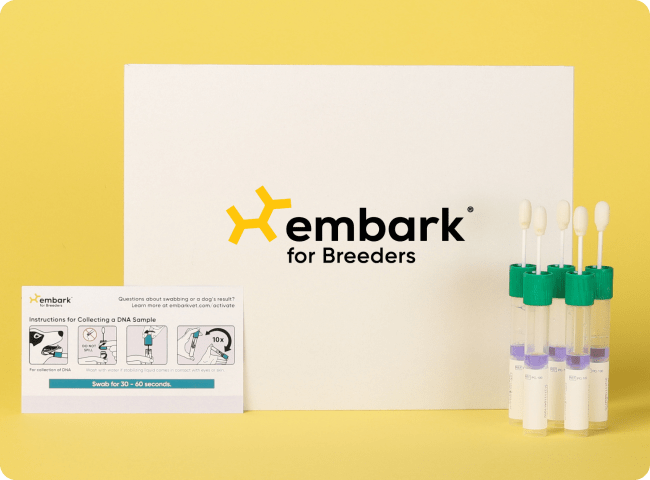Intervertebral Disc Disease (Type I)
Type I Intervertebral Disc Disease (IVDD) is a back/spine issue that refers to a health condition affecting the discs that act as cushions between vertebrae. With Type I IVDD, affected dogs can have a disc event where it ruptures or herniates towards the spinal cord. This pressure on the spinal cord causes neurologic signs which can range from a wobbly gait to impairment of movement. Chondrodystrophy (CDDY) refers to the relative proportion between a dog’s legs and body, wherein the legs are shorter and the body longer. There are multiple different variants that can cause a markedly chondrodystrophic appearance as observed in Dachshunds and Corgis. However, this particular variant is the only one known to also increase the risk for IVDD.
-
Signs and symptoms
Research indicates that dogs with one or two copies of this variant have a similar risk of developing IVDD. However, there are some breeds (e.g. Beagles and Cocker Spaniels, among others) where this variant has been passed down to nearly all dogs of the breed and most do not show overt clinical signs of the disorder. This suggests that there are other genetic and environmental factors (such as weight, mobility, and family history) that contribute to an individual dog’s risk of developing clinical IVDD. Signs of IVDD include neck or back pain, a change in your dog's walking pattern (including dragging of the hind limbs), and paralysis. These signs can be mild to severe, and if your dog starts exhibiting these signs, you should schedule an appointment with your veterinarian for a diagnosis.
Signs of CDDY are recognized in puppies as it affects body shape. IVDD is usually first recognized in adult dogs, with breed specific differences in age of onset. -
Diagnosis
For CDDY, dogs with one copy of this variant may have mild proportional differences in their leg length. Dogs with two copies of this variant will often have visually longer bodies and shorter legs. For IVDD, a neurological exam will be performed on any dog showing suspicious signs. Based on the result of this exam, radiographs to detect the presence of calcified discs or advanced imaging (MRI/CT) to detect a disc rupture may be recommended.
-
Treatment
IVDD is treated differently based on the severity of the disease. Mild cases often respond to medical management which includes cage rest and pain management, while severe cases are often treated with surgical intervention. Both conservative and surgical treatment should be followed up with rehabilitation and physical therapy.
-
What to do if your dog is at risk
Actions
- Follow veterinary advice for diet, weight management, and daily exercise. Overweight dogs and those with insufficient exercise are thought to be at higher risk of developing clinical disease.
- Ramps up to furniture, avoiding flights of stairs, and using a harness on walks will also help minimize some of the risk of an IVDD event by reducing stress on the back.
- In breeds where this variant is extremely common, this genetic health result should not be a deciding factor when evaluating a dog for breeding or adoption purposes.
-
Genetic Information
Please note that this variant is extremely common in many small and chondrodystrophic dog breeds. In these breeds, this variant may not be the strongest predictor of IVDD risk compared to other genetic or environmental factors.
A dog with one copy of this variant may have slightly shorter legs in relation to body size. A dog with two copies of this mutation will have much shorter legs and a longer body. A dog with one or two copies of this variant has an increased risk of developing IVDD. Research has shown that one or two copies of this variant creates a 46 fold increase in risk for an IVDD event and a 5-15 fold increase in risk for disc surgery.
Gene names:
FGF4 - chr12 ‐ chr
Inheritance type:
dominant
Citations:
-
Breeds affected
This health condition affects the following breeds
-
Basset Hound

-
Beagle

-
Bichon Frise

-
French Bulldog

-
Cardigan Welsh Corgi

-
Cavalier King Charles Spaniel

-
Chesapeake Bay Retriever

-
Chihuahua

-
Chinese Crested

-
Cocker Spaniel

-
Coton de Tulear

-
Dachshund

-
Dandie Dinmont Terrier

-
English Cocker Spaniel

-
English Springer Spaniel

-
Havanese

-
Nova Scotia Duck Tolling Retriever

-
Pekingese

-
Pembroke Welsh Corgi

-
Poodle (Standard)

-
Poodle (Small)

-
Portuguese Water Dog

-
Russell-type Terrier

-
Scottish Terrier

-
Shih Tzu

-
Teddy Roosevelt Terrier

-
Learn about your dog’s unique genetic health
Dog owners
Breed identification, health and trait insights, personalized care recommendations, and the world’s first canine relative finder—all in one leading dog DNA test.
Learn about the report for dog ownersShop the test
Breeding programs
Embark’s test for breeding programs is one comprehensive DNA test designed with your needs in mind.
Learn about the report for breedersShop the test


